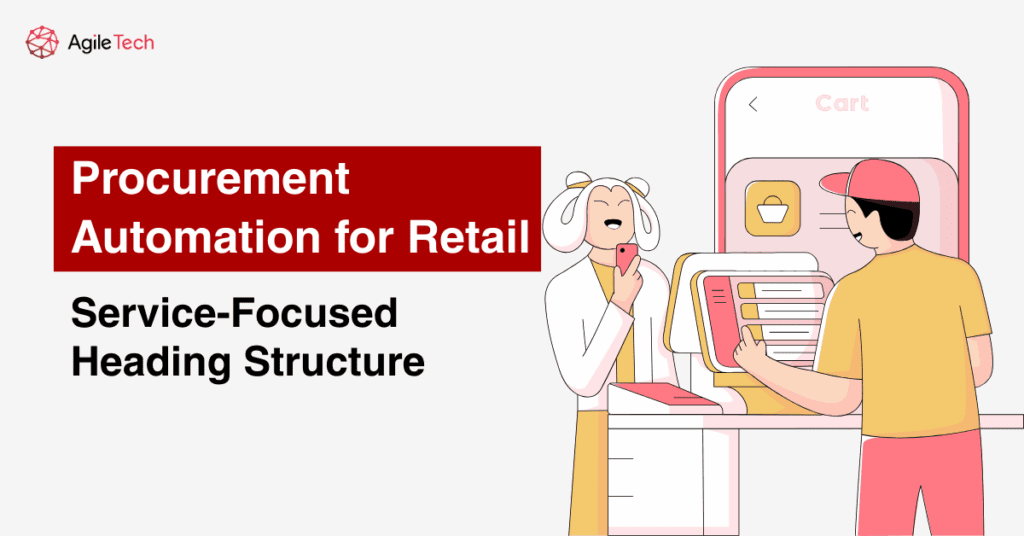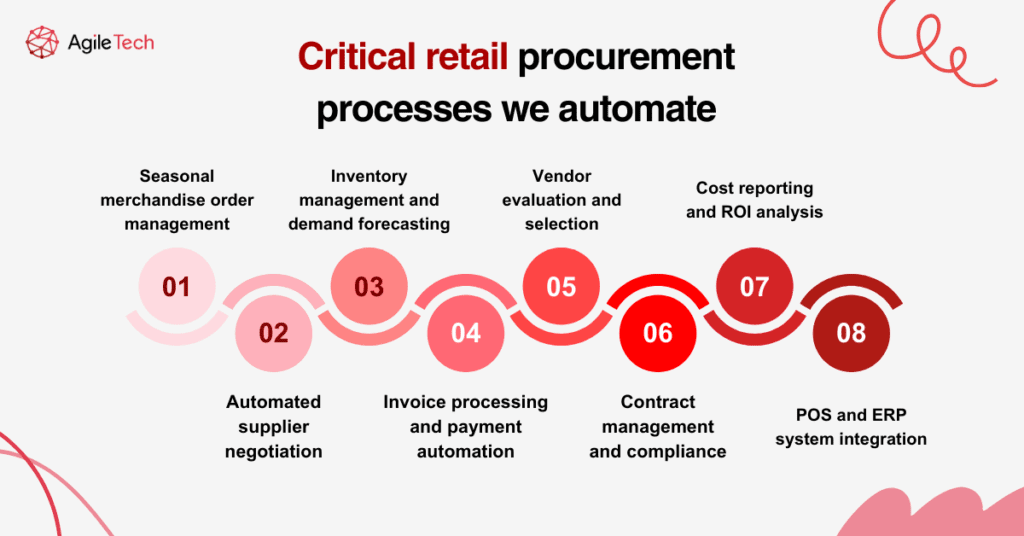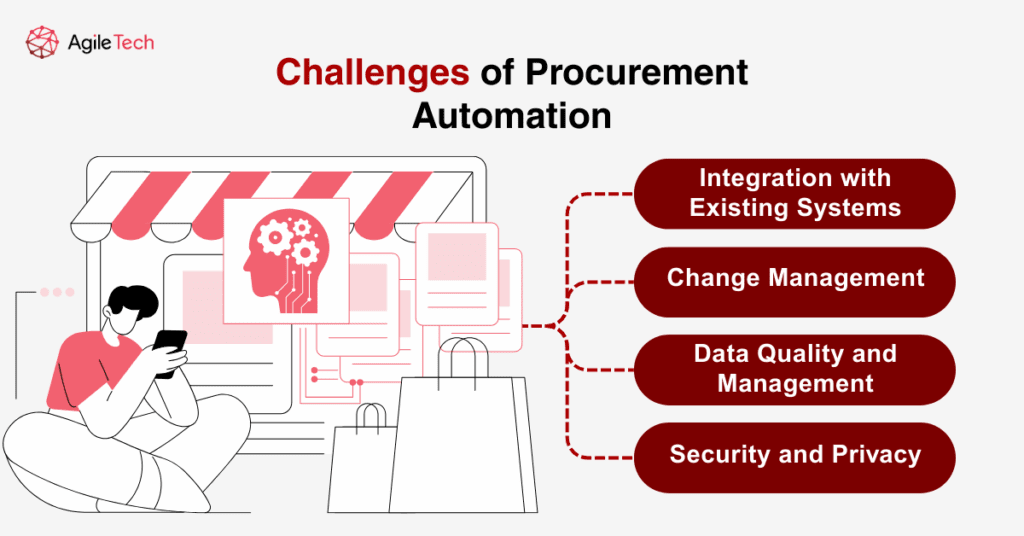Procurement Automation for Retail: Service-Focused Heading Structure
The retail industry stands at a pivotal moment where traditional procurement methods are rapidly becoming obsolete. As consumer expectations continue to evolve and market dynamics shift at unprecedented speeds, retailers are turning to procurement automation as a critical strategic advantage. With the global procurement automation software market expanding rapidly and retail remaining the leading industry vertical, accounting for 19.4% of the market share in 2025, understanding how automated procurement systems can transform your operations has never been more essential.

1. Why do retail companies need Procurement Automation services?
Modern retail companies face an increasingly complex landscape that demands sophisticated automated purchasing solutions. The traditional manual approaches that once sufficed are now inadequate for addressing the multifaceted challenges that define today’s retail environment. The retail sourcing and procurement market is projected to grow from USD 5.0 billion in 2025 to USD 12.9 billion by 2035, at a CAGR of 10.0%, indicating the critical importance of automation in procurement for maintaining competitive positioning.
1.1. Procurement challenges specific to the retail industry
Retail procurement operates within a unique ecosystem characterized by extreme seasonality, rapidly changing consumer preferences, and the constant pressure to maintain optimal inventory levels while minimizing carrying costs. Unlike other industries, retailers must navigate the complexities of fashion cycles, promotional periods, and the growing demand for personalization while managing thousands of SKUs across multiple channels.
The challenge extends beyond simple product sourcing to encompass complex supplier relationships, quality control across diverse product categories, and the need to maintain consistent availability while avoiding overstock situations. Retailers also face the additional complexity of managing both national brand relationships and private label development simultaneously, requiring different procurement strategies and vendor management approaches.
1.2. Competitive pressure and cost optimization needs
The retail landscape has become increasingly competitive, with margins under constant pressure from both traditional competitors and new digital entrants. Leading organizations are using AI-powered contract management within their automated procurement systems to reduce costs by up to 15% in 2025, demonstrating the significant impact that procurement automation software can have on bottom-line performance.
Cost optimization in retail procurement extends beyond simple price negotiations to encompass total cost of ownership, including logistics, inventory carrying costs, and the hidden expenses associated with stockouts or excess inventory. The pressure to deliver value to consumers while maintaining profitability requires a level of procurement sophistication that can only be achieved through automation in procurement systems that provide real-time insights and enable data-driven decision-making.
Read more: How to Implement A Procurement System: Key Steps & Tips for Success
2. Critical retail procurement processes we automate

Successful procurement automation in retail requires a comprehensive approach that addresses each critical component of the automated purchasing lifecycle. Rather than implementing isolated solutions, leading retailers are adopting integrated procurement automation software platforms that create seamless workflows across all procurement functions.
2.1. Seasonal merchandise order management
Seasonal merchandise presents one of the most complex procurement challenges in retail, requiring precise timing, accurate demand forecasting, and flexible supplier arrangements. Automated seasonal merchandise management systems utilize historical sales data, market trends, and predictive analytics to optimize ordering decisions and timing.
These automated procurement systems automatically adjust order quantities based on real-time sales performance, weather patterns, and market conditions, ensuring that retailers can respond quickly to changing demand without manual intervention. The automation extends to managing pre-season commitments, in-season adjustments, and end-of-season clearance strategies, providing retailers with the agility needed to maximize seasonal profitability.
2.2. Automated supplier negotiation
Modern supplier negotiation automation leverages artificial intelligence and market intelligence to optimize contract terms and pricing structures. These procurement automation software solutions continuously monitor market conditions, supplier performance metrics, and competitive pricing to identify negotiation opportunities and automatically propose contract modifications.
The automation process includes dynamic pricing models that adjust to market fluctuations, automated renewal negotiations based on predefined criteria, and intelligent contract optimization that considers factors beyond simple price, including quality metrics, delivery performance, and strategic value. This approach ensures that retailers maintain optimal supplier relationships while achieving the best possible terms.
2.3. Inventory management and demand forecasting
Inventory management automation integrates demand forecasting, supply planning, and replenishment processes into a cohesive system that responds automatically to changing market conditions. Advanced algorithms analyze multiple data sources, including point-of-sale data, social media trends, weather patterns, and economic indicators, to generate accurate demand predictions.
These automated purchasing systems automatically generate purchase orders, adjust safety stock levels, and optimize inventory allocation across channels and locations. The integration with supplier systems enables automatic communication of demand changes and delivery requirements, creating a responsive supply chain that minimizes both stockouts and excess inventory.
2.4. Invoice processing and payment automation
Automated invoice processing eliminates the time-consuming manual tasks associated with accounts payable while reducing errors and improving supplier relationships. These systems automatically match invoices to purchase orders and receiving documents, flag discrepancies for review, and process approved payments according to predefined terms.
The automation extends to dynamic discounting opportunities, where systems automatically evaluate early payment discounts against cash flow requirements and investment alternatives. Advanced systems also provide automated supplier communication regarding payment status and discrepancy resolution, improving overall supplier satisfaction and relationship management.
2.5. Vendor evaluation and selection
Automated vendor evaluation systems continuously assess supplier performance across multiple dimensions, including quality, delivery reliability, cost competitiveness, and strategic alignment. These systems automatically score suppliers based on weighted criteria and identify opportunities for consolidation or diversification.
The automation includes real-time performance monitoring, automated scorecarding, and predictive analytics that identify potential supplier risks before they impact operations. This continuous evaluation process ensures that retailers maintain optimal supplier portfolios and can quickly respond to performance issues or market opportunities.
2.6. Contract management and compliance
Contract management automation ensures that all supplier agreements are properly executed, monitored, and optimized throughout their lifecycle. These systems automatically track contract terms, renewal dates, and performance obligations while identifying opportunities for renegotiation or termination.
Compliance monitoring includes automated verification of supplier certifications, regulatory requirements, and quality standards. The systems generate automatic alerts for compliance violations and provide detailed audit trails for regulatory reporting. This comprehensive approach reduces legal risks and ensures that all procurement activities align with corporate policies and regulatory requirements.
2.7. Cost reporting and ROI analysis
Automated cost reporting systems provide real-time visibility into procurement performance and return on investment across all categories and suppliers. These systems automatically calculate total cost of ownership, track savings achievement, and identify additional optimization opportunities.
The reporting automation includes predictive analytics that forecast future costs and savings potential, enabling proactive procurement strategy adjustments. Advanced visualization tools present complex data in actionable formats, allowing procurement teams to quickly identify trends and make informed decisions about future procurement strategies.
2.8. POS and ERP system integration
Seamless integration between procurement automation systems and existing retail technology infrastructure is essential for maximizing the value of automated procurement system investments. Cloud deployment models lead with a 68.0% share in the retail procurement market, reflecting the importance of flexible, integrated solutions.
This integration enables real-time data flow between point-of-sale systems, inventory management, and automation in procurement platforms, creating a unified view of demand and supply across the entire retail operation. The integration also ensures that procurement decisions are automatically reflected in all relevant systems, maintaining data consistency and operational efficiency.
3. What benefits of procurement automation?
The implementation of procurement automation delivers measurable benefits across multiple dimensions of retail operations. These benefits compound over time as automated procurement systems learn and optimize, creating sustainable competitive advantages that extend far beyond simple cost savings.
3.1. Increased Efficiency and Speed
Procurement automation dramatically reduces the time required to complete routine procurement tasks while improving the quality and consistency of outcomes. Automated workflows eliminate bottlenecks and manual handoffs that traditionally slow procurement processes, enabling retailers to respond quickly to market opportunities and changing customer demands.
The speed improvements extend beyond individual transactions to encompass strategic procurement activities such as supplier evaluation, market analysis, and contract negotiation. This increased velocity enables retailers to capitalize on time-sensitive opportunities and maintain competitive positioning in rapidly changing markets.
Automated Workflows create standardized processes that ensure consistent execution while reducing the potential for human error. These workflows automatically route approvals, trigger notifications, and update relevant systems, creating seamless procurement operations that require minimal manual intervention.
Reduced Errors result from the elimination of manual data entry and the implementation of automated validation checks throughout the procurement process. This reduction in errors not only improves operational efficiency but also enhances supplier relationships by reducing disputes and payment delays.
3.2. Cost Savings
The financial impact of procurement automation extends across multiple cost categories, from direct purchase price improvements to operational efficiency gains. The cumulative effect of these savings can significantly impact retail profitability and competitive positioning.
Operational Cost Reduction occurs through the elimination of manual processes, reduced headcount requirements, and improved resource utilization. Automated systems enable procurement teams to focus on strategic activities rather than routine transactions, maximizing the value of human resources while reducing overall operational costs.
Better Negotiations are enabled through improved market intelligence, automated benchmarking, and data-driven negotiation strategies. Procurement automation software provides procurement professionals with comprehensive supplier performance data and market insights that support more effective negotiation outcomes.
3.3. Improved Compliance and Risk Management
Automated compliance monitoring and risk assessment capabilities provide retailers with comprehensive protection against regulatory violations and operational disruptions. These systems continuously monitor supplier performance and market conditions to identify potential risks before they impact business operations.
Regulatory Adherence is ensured through automated monitoring of changing regulations and automatic updates to procurement policies and procedures. These systems maintain comprehensive audit trails and generate reports required for regulatory compliance, reducing the administrative burden on procurement teams.
Audit Trails provide complete documentation of all procurement activities, supporting both internal audits and regulatory reviews. The automated generation of audit documentation ensures that all activities are properly recorded and easily accessible when required for compliance or performance analysis.
3.4. Enhanced Transparency and Accountability
Procurement automation creates unprecedented visibility into all aspects of the procurement process, enabling better decision-making and improved stakeholder communication. This transparency builds trust with both internal stakeholders and external suppliers while supporting more effective performance management.
Real-Time Tracking provides continuous visibility into procurement activities, supplier performance, and cost trends. This real-time information enables proactive management of procurement operations and quick response to emerging issues or opportunities.
Stakeholder Communication is enhanced through automated reporting and notification systems that keep all relevant parties informed of procurement status and performance. This improved communication reduces misunderstandings and supports more effective collaboration across the organization.
3.5. Data-Driven Decisions
The wealth of data generated by automated procurement systems enables sophisticated analytics and predictive modeling that support strategic decision-making. This data-driven approach moves procurement from a reactive function to a proactive strategic capability that drives business value.
Advanced analytics capabilities provide insights into market trends, supplier performance patterns, and optimization opportunities that would be impossible to identify through manual analysis. These insights enable retailers to make more informed procurement decisions and develop more effective procurement strategies.
Read more: Optimizing Freight Procurement in Transportation & Logistics with Custom Software Solutions
4. Challenges of Procurement Automation

While the benefits of procurement automation are substantial, successful implementation requires careful consideration of potential challenges and appropriate mitigation strategies. Understanding these challenges upfront enables retailers to develop more effective implementation plans and achieve better outcomes from their automation in procurement investments.
4.1. Integration with Existing Systems:
High initial investments are challenges expected to restrain segment growth in the retail procurement automation market, reflecting the complexity of integrating new automation solutions with existing retail technology infrastructure. Legacy systems often lack the APIs and data standards required for seamless integration, requiring custom development or system replacements.
The integration challenge extends beyond technical compatibility to include data mapping, process alignment, and user training requirements. Successful integration requires careful planning, phased implementation approaches, and ongoing technical support to ensure that automated systems work effectively with existing retail operations.
4.2. Change Management:
The transition from manual to automated procurement processes requires significant organizational change management to ensure user adoption and realize the full benefits of automation. Resistance to change, inadequate training, and unclear communication can undermine even the most technically sound automation implementations.
Effective change management requires comprehensive training programs, clear communication of benefits, and ongoing support for users as they adapt to new processes. The most successful implementations involve procurement teams in the design and testing of automated systems, ensuring that the final solution meets their needs and supports their work processes.
4.3. Data Quality and Management:
Automated procurement systems are only as effective as the data they process, making data quality a critical success factor for automation implementations. Poor data quality can lead to incorrect decisions, supplier relationship issues, and operational disruptions that undermine the value of automation investments.
Establishing comprehensive data governance processes, implementing data validation controls, and providing ongoing data quality monitoring are essential components of successful procurement automation. This includes standardizing supplier information, product data, and pricing information across all systems and processes.
4.4. Security and Privacy
The centralization of procurement data and processes in automated systems creates new security and privacy risks that must be carefully managed. These systems often contain sensitive supplier information, pricing data, and strategic procurement plans that could be valuable to competitors or malicious actors.
Comprehensive security measures, including access controls, encryption, and regular security audits, are essential for protecting sensitive procurement data. Additionally, compliance with data privacy regulations requires careful consideration of how supplier and customer data is collected, processed, and stored within automated systems.
5. AgileTech’s Procurement Automation service
AgileTech’s comprehensive procurement automation service is designed specifically for retail companies seeking to transform their procurement operations through strategic automation implementation. Our proven methodology ensures successful deployment and measurable results while minimizing implementation risks and operational disruption.
Step 1: Free assessment and consultation
Our procurement automation journey begins with a comprehensive assessment of your current procurement processes, technology infrastructure, and strategic objectives. This no-obligation evaluation provides detailed insights into automation opportunities, potential challenges, and expected return on investment for your specific situation.
The assessment includes analysis of your supplier base, transaction volumes, process maturity, and integration requirements to develop a customized automation roadmap. Our experienced consultants work closely with your procurement team to understand your unique requirements and constraints, ensuring that our recommendations align with your business objectives and operational realities.
Step 2: Customized solution design
Based on the assessment findings, our team develops a customized procurement automation solution that addresses your specific requirements while leveraging industry best practices and proven technologies. The solution design includes detailed process flows, system architecture, integration requirements, and implementation timelines.
Our design approach emphasizes scalability and flexibility, ensuring that your automation solution can grow and evolve with your business requirements. We also prioritize user experience and change management considerations, designing solutions that are intuitive and supportive of your team’s work processes.
Step 3: Implementation and training
Our experienced implementation team manages all aspects of system deployment, data migration, and integration with your existing technology infrastructure. We follow proven project management methodologies and maintain close communication with your team throughout the implementation process to ensure successful deployment.
Comprehensive training programs ensure that your procurement team is fully prepared to utilize the new automated systems effectively. Our training approach includes hands-on workshops, process documentation, and ongoing support to ensure smooth transition and user adoption.
Step 4: Ongoing support and optimization
Post-implementation support includes performance monitoring, system optimization, and continuous improvement initiatives that maximize the value of your automation investment. Our support team provides technical assistance, process optimization recommendations, and strategic guidance to help you achieve your procurement objectives.
Regular performance reviews and optimization assessments ensure that your automated systems continue to deliver value as your business evolves. We also provide updates and enhancements that incorporate new technologies and industry best practices, keeping your procurement automation solution current and competitive.
Read more: How to Integrate Procurement System with ERP for Seamless Supply Chain
Conclusion
Procurement automation represents a transformative opportunity for retail companies to enhance operational efficiency, reduce costs, and improve competitive positioning in an increasingly challenging market environment. With the global procurement software market growing from USD 7,877.2 million in 2025 to USD 21,873.6 million by 2035, and retail accounting for 19.4% of the market share, the adoption of automated procurement solutions is becoming essential for maintaining competitive advantage.
The comprehensive benefits of procurement automation, from increased efficiency and cost savings to improved compliance and data-driven decision making, far outweigh the implementation challenges when approached with proper planning and expert guidance. As retailers face continuing pressure to optimize operations and reduce costs, procurement automation provides a proven path to sustainable competitive advantage.
AgileTech’s service-focused approach to procurement automation ensures that retail companies can successfully navigate the implementation process and achieve measurable results from their automation investments. Through our proven methodology and ongoing support, we help retailers transform their procurement operations and unlock the full potential of automation technology.